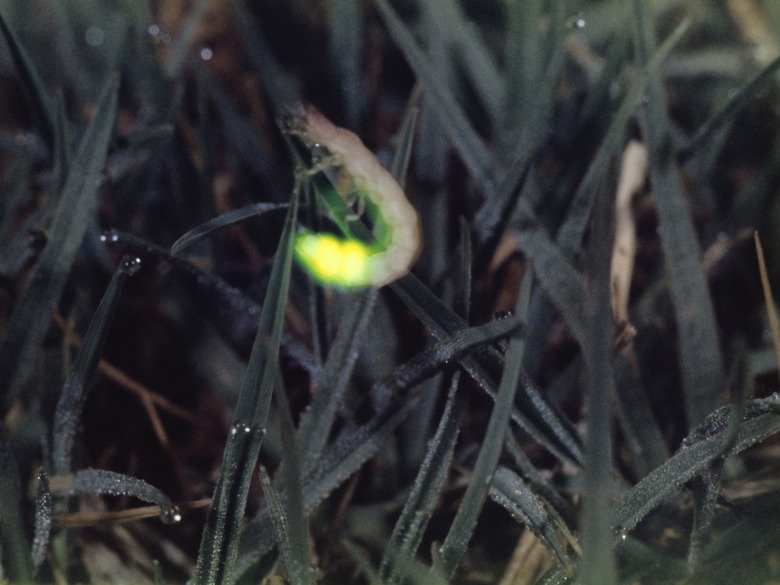How To Tell A Female Firefly Apart From A Male Firefly
Lightning bugs of the beetle family Lampyridae (order Coleoptera), also known as fireflies, get their name because of their unique bioluminescent abilities. The world has over 2,000 species of lightning bugs spread across every continent except Antarctica. Lightning bugs primarily use their bioluminescent organs located near the tip of their abdomen to communicate with each other and avoid predators.
Bioluminescence
Bioluminescence
Lightning bugs convert chemical energy into light energy using two key ingredients: the chemical luciferin and oxygen, in a special form called superoxide anion. This bioluminescent "cold" light production process is highly efficient as heat is not a byproduct. In some species, it's not only the adult male and female lightning bugs that glow – the eggs will also flash when tapped or vibrated gently. Lightning bug light colors can appear yellow, orange, green or blue.
Avoiding Predators
Avoiding Predators
It might seem contradictory to use a bright light to avoid predators, but it may be a warning signal. Many species of lightning bugs contain defensive steroids called lucibufagins. These bitter, noxious and sometimes toxic chemicals help deter predators such as jumping spiders (Phidippus spp.) and birds from eating them.
To prevent being killed in an attack, the lightning bugs quickly shed a few drops of bitter blood for the predator to taste in a response called "reflex bleeding." However, not all lightning bugs contain enough of these chemicals to cause harm to predators, so they use their light as a trick, pretending to be one of their bad-tasting cousins.
Monomorphic Lightning Bugs
Monomorphic Lightning Bugs
Many species of lightning bugs are monomorphic. This means that by looking at them, the male and female of a species look the same, or at least very similar. Typically, the only way to tell the sex of a monomorphic species is to look at their genitalia, and for insects, this usually means dissection is required. However, in some lightning bug species, the males and females can be identified based on their communication light flashes.
Lightning Bug Communication
Lightning Bug Communication
Not every species flashes, but of those that do, each lightning bug species has a specialized flash pattern to attract mates of the opposite gender. Males fly around in the night, flashing their bioluminescent light organ for females to see while the female flashes back at him from her perch. The females draw the male in with single flashes or long pulses. The timing between a female's flashes varies from species to species.
Male Versus Female Lightning Bugs
Male Versus Female Lightning Bugs
Occasionally a female lightning bug of the genus Photinus will lure a male lightning bug of the genus Photuris in with the courtship flash patterns of his species. When he gets close enough, instead of mating with him, she attacks and eats him to consume his nutrients and predator-deterring chemicals. These females are affectionately called "femme-fatales."
Male and Female Differences
Male and Female Differences
Aside from the flashing method for identifying a male from a female lightning bug, many species are sexually dimorphic, meaning the adult males and females look different. How they are sexually dimorphic varies widely from species to species. For example, in the genera Microphotus and Lapyris, the females look like larvae and have no wings, while the males look like beetles and can fly. In addition, the females are much larger in the species Photuris versicolor, measuring 0.59 to 0.71 inches long, compared to the males at 0.39 to 0.59 inches long.
In the species Luciola lusitanica, also known as the Portuguese firefly, the females are both larger than the males and have wings. However, she doesn't use her wings to fly – instead, the female is often found on low-lying vegetation and the ground. The benefit of being larger and not flying is that she can put more energy towards producing more eggs.
Cite This Article
MLA
Jerrett, Adrianne. "How To Tell A Female Firefly Apart From A Male Firefly" sciencing.com, https://www.sciencing.com/tell-firefly-apart-male-firefly-5788312/. 30 September 2021.
APA
Jerrett, Adrianne. (2021, September 30). How To Tell A Female Firefly Apart From A Male Firefly. sciencing.com. Retrieved from https://www.sciencing.com/tell-firefly-apart-male-firefly-5788312/
Chicago
Jerrett, Adrianne. How To Tell A Female Firefly Apart From A Male Firefly last modified March 24, 2022. https://www.sciencing.com/tell-firefly-apart-male-firefly-5788312/
